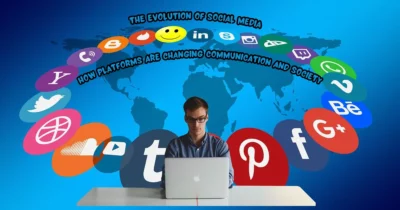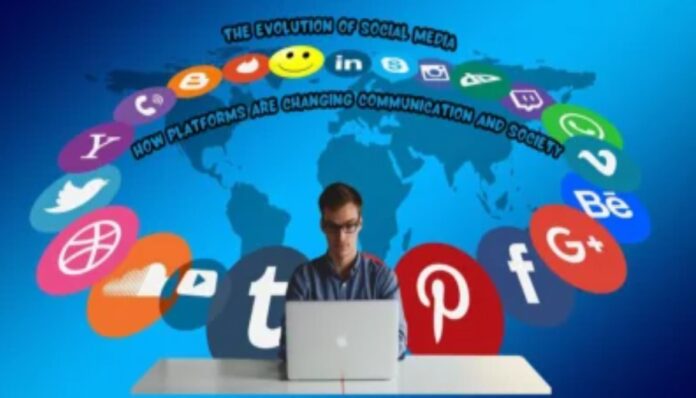
Social media has had a significant impact on how we communicate and interact with each other. Over the past decade, social media platforms have evolved from simple communication tools to complex ecosystems that shape our behavior, influence our opinions, and connect us with people and ideas from around the world.
In this article, we will explore the evolution of social media, from its early beginnings to its current state, and examine how it is changing communication and society.
The Early Days of Social Media
Social media has its roots in early Internet chat rooms and bulletin boards. People would gather to discuss common interests and share information. In the late 1990s, sites like Friendster and MySpace emerged. They offered users a platform to create profiles, connect with friends, and share content.
These early social networks were primarily used by young people and tech enthusiasts, but they quickly gained popularity as a new way to communicate and connect online.
The history of social media can be traced back to the early days of the Internet when bulletin boards and chat rooms were the primary means of online communication.
However, it wasn’t until the emergence of Web 2.0 technologies in the mid-2000s. It was social media began to take shape as we know it today.
The first social networking site to gain widespread popularity was Friendster, which was launched in 2002. Friendster was designed to help people connect with friends and make new ones online.
It allowed users to create profiles, list their interests and hobbies, and connect with others who shared similar interests.
MySpace
In 2003, MySpace was launched, and quickly became the most popular social networking site in the world. MySpace was primarily used by young people and offered users the ability to create personalized profiles, upload photos and videos, and connect with friends and acquaintances.
At its peak, MySpace had over 100 million users worldwide.

The Rise of Facebook:
In 2004, Facebook was launched as a social networking site for college students. It quickly grew in popularity, and by 2008, it had become the largest social network in the world.
Facebook’s success was due to its user-friendly interface, easy-to-use privacy settings, and powerful network effects. Users could create profiles, share photos and videos, and connect with friends and family members from around the world. /ulzaey7gpju
The Emergence of Twitter
In 2006, Twitter was launched as a micro-blogging platform that allowed users to share short messages, or tweets, with their followers. Twitter quickly became a popular tool for breaking news, celebrity gossip, and political commentary.
It also enabled users to connect with people they may not have been able to connect with otherwise. This includes people such as public figures, journalists, and experts in various fields.
Snapchat
In 2011, Snapchat was launched as a mobile app. It allowed users to send photos and videos that would disappear after a short time.
Snapchat quickly became popular among teenagers and young adults and introduced the concept of “stories” – a collection of photos and videos that could be viewed for 24 hours before disappearing.
The Rise of Visual Social Media:
In 2010, Instagram was launched as a mobile photo-sharing app. It quickly gained popularity among young people, who were drawn to its simple and easy-to-use interface.
Instagram’s success was due in part to its focus on visual content, with users sharing photos and videos of their daily lives, hobbies, and interests.
In 2012, Pinterest was launched as a visual bookmarking site. Users could create boards and pin images of products, recipes, and other content they found interesting. Pinterest quickly became a popular tool for people planning weddings, home renovations, and other projects.
The Current State of Social Media
Today, social media is a multi-billion dollar industry that encompasses a wide range of platforms and services. Facebook remains the largest social network in the world, with over 2 billion active users.
Instagram and Twitter are also popular platforms, with hundreds of millions of users each and they have high influence.
In addition to these major platforms, there are also a number of niche social networks and messaging apps that cater to specific audiences and interests.
For example, LinkedIn is a professional networking site that connects job seekers with employers, while TikTok is a video-sharing app that is popular among teenagers and young adults.

How Social Media is Changing Communication:
Social media has fundamentally changed the way we communicate with each other. Here are some of the ways in which social media has impacted communication:
Instant Communication: Social media enables us to communicate with people in real time, regardless of where they are in the world.
This has made it easier to stay in touch with friends and family members who live far away. Also to collaborate with colleagues and business partners in different time zones.
Diverse Communication Channels: Social media offers a variety of communication channels, from text-based messaging to video chat. This enables users to choose the communication method that best suits their needs and preferences.
Greater Reach: Social media enables us to reach a wider audience than ever before.
Pros
Increased connectivity: Social media platforms have made it easier than ever to connect with people from all around the world. This has led to increased social connectivity, as people are able to maintain relationships with friends & family members who may be far away.
Greater access to information: Social media has made it easier for people to access news, information, and expert opinions on a wide range of topics. This has enabled people to become more informed and educated about the world around them.
Improved communication: Social media platforms have made it easier to communicate with others in real time, regardless of their location. This has led to increased collaboration and productivity in many fields, including business, education, and healthcare.
Enhanced personalization: Social media platforms use algorithms to personalize users’ experiences based on their interests, preferences, and online behavior. This has led to more targeted advertising, as well as a more personalized user experience.
Cons:
Cyberbullying: Social media platforms have been criticized for facilitating cyberbullying and harassment, particularly among young people. This has led to increased mental health problems, including anxiety and depression.
Spread of misinformation: Social media has been blamed for the spread of fake news and misinformation. This is particularly important during elections and other important events. This has led to increased polarization and mistrust in society.
Addiction: Social media can be addictive, with many users spending hours each day scrolling through their feeds. This can lead to decreased productivity, as well as negative impacts on mental and physical health.
Privacy concerns: Social media platforms collect vast amounts of user data, which can be used for targeted advertising & other purposes. This has led to concerns about privacy, as well as the potential for misuse of personal information.
Decreased face-to-face interaction: Social media can lead to decreased face-to-face interaction, as people may rely more on online communication than in-person interactions. This can lead to social isolation and loneliness.
Conclusion
In conclusion, the evolution of social media has had a significant impact on the way people communicate and interact with each other, as well as on society as a whole. The emergence of social media platforms has enabled increased connectivity, improved communication, and greater access to information.
However, it has also given rise to a range of concerns, including cyberbullying, the spread of misinformation, addiction, privacy concerns, and decreased face-to-face interaction.










